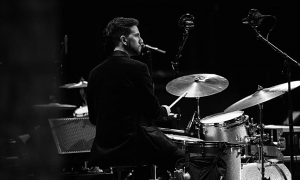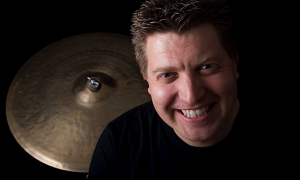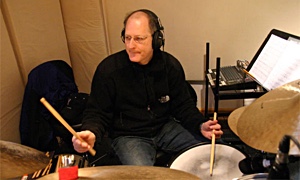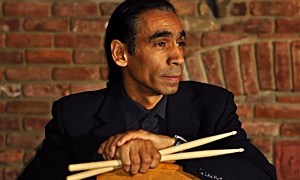Home » Jazz Articles » Rhythm In Every Guise » Cecil Brooks III: Double Exposure
Cecil Brooks III: Double Exposure
...first and foremost, Brooks is an excellent drum set stylist.
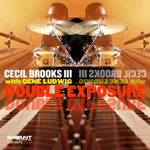 Released on Savant in 2006, the session within a session is entitled Double Exposure. It serves as a reminder that, first and foremost, Brooks is an excellent drum set stylist. The duo takes Ferde Grofe's "On The Trail, the disc's opening track, at a medium-to-up tempo. The drums and cymbals speak in a manner that is both crisp and relatively light. They cut through but don't compete with the alternatively warm and keening sound of Ludwig's keyboard, and the agreeable hum of his bass pedals.
Released on Savant in 2006, the session within a session is entitled Double Exposure. It serves as a reminder that, first and foremost, Brooks is an excellent drum set stylist. The duo takes Ferde Grofe's "On The Trail, the disc's opening track, at a medium-to-up tempo. The drums and cymbals speak in a manner that is both crisp and relatively light. They cut through but don't compete with the alternatively warm and keening sound of Ludwig's keyboard, and the agreeable hum of his bass pedals.
During an eight-bar opening, Brooks accompanies Ludwig on the hi-hat cymbal and snare drum, starting off softly and gradually becoming a little louder, before adding a stuttering three-stroke fill at the end. As they play the head, Brooks introduces another level of rhythmic complexity without making any waves. His snare accents chafe against Ludwig's straightforward interpretation of Grofe's melody and half-time feel bass line.
Throughout Ludwig's five chorus solo, Brooks stays close to the organist, listens closely, and carefully chooses places to assert himself. He utilizes hard accents only as punctuation, and employs snare strokes closely tied to Ludwig's occasional, abrupt two and three note sallies. At the onset of the third chorus, Ludwig starts to quote Dizzy Gillespie's "Salt Peanuts. In an instant, Brooks joins him with solid hits to the snare and tom-tom, as well as one shot to the bass drum after the quote is complete.
The duo's rendition of the standard "Tea For Two features Brooks' drum breaks and an extended solo. He inserts two-bar breaks at the end of three of the tune's four eight-bar segments. In contrast to Ludwig's staid, almost polite treatment of the melody, Brooks' snare on the first two breaks goes off like a string of firecrackers. It's not bombastic; just startling. The last break is comparatively sparse, funkier, and includes a couple of well-placed hits to the bass drum.
Brooks comes out swinging at the onset of his solo. He plays relatively simple figures to the snare and, to a lesser extent, the toms and bass drum. For the first sixteen bars, he's thinking in eight-bar segments. Halfway through the first chorus things become denser and somewhat less focused. The pulse is now implied instead of explicitly stated, but signs of familiarity appear in the form of recognizable fragments mixed into a very thick stew.
At the end of the first chorus, Brooks cuts loose with bursts of snare drum rolls that sound like wheels sliding on gravel. He then starts playing snare and tom-tom patterns, each of which seems to have a mind of its own. The second chorus approximates free form, but brief, accessible pieces move in and out of the rush of sounds.
There's never a dull moment as Brooks and Ludwig prod one another throughout a Latin-oriented, up-tempo take on Stevie Wonder's "Bird of Beauty. The track is one long chain of agitated movement. Even though Ludwig plays the melody and is the only soloist, the purposeful chatter of Brooks' snare drum and ride cymbal makes him an equal partner.
The disc's title track is a slow-to-medium tempo blues that mostly features Brooks' trap set. On the opening two choruses, Ludwig plays a walking line and Brooks solos over it. All substance and no flash, it's the antithesis of a traditional drum feature. Aside from the faint sound of the hi-hat on beats two and four, Brooks creates quasi-melodies by utilizing various combinations of the snare (with the snares off) and tom-toms. He makes deliberate, almost studied strokes, and executes patterns that are brief and to the point, leaving pauses to allow individual phrases to sink in. You can hear the ring of overtones on nearly every stroke. Some of the rhythms resemble marching band street beats, but they're not as tightly focused and he never strikes the drums hard. All in all, Brooks' utility and willingness to think his way through the solo is much more satisfying than any showy display of technical prowess.
Comments
Tags
For the Love of Jazz
 All About Jazz has been a pillar of jazz since 1995, championing it as an art form and, more importantly, supporting the musicians who create it. Our enduring commitment has made "AAJ" one of the most culturally important websites of its kind, read by hundreds of thousands of fans, musicians and industry figures every month.
All About Jazz has been a pillar of jazz since 1995, championing it as an art form and, more importantly, supporting the musicians who create it. Our enduring commitment has made "AAJ" one of the most culturally important websites of its kind, read by hundreds of thousands of fans, musicians and industry figures every month.






